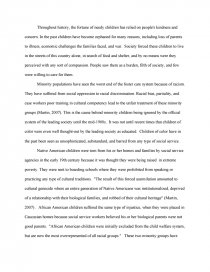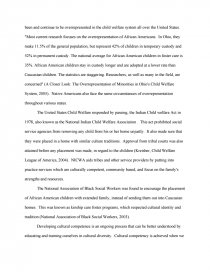History of Minority Populations in the Child Welfare System
Essay by Kill009 • March 6, 2012 • Essay • 842 Words (4 Pages) • 1,846 Views
Essay Preview: History of Minority Populations in the Child Welfare System
Throughout history, the fortune of needy children has relied on people's kindness and concern. In the past children have become orphaned for many reasons, including loss of parents to illness, economic challenges the families faced, and war. Society forced these children to live in the streets of this country alone, in search of food and shelter, and by no means were they perceived with any sort of compassion. People saw them as a burden, filth of society, and few were willing to care for them.
Minority populations have seen the worst end of the foster care system because of racism. They have suffered from social oppression to racial discrimination. Racial bias, partiality, and case workers poor training in cultural competency lead to the unfair treatment of these minority groups (Martin, 2007). This is the cause behind minority children being ignored by the official system of the leading society until the mid-1900s. It was not until recent times that children of color were even well thought-out by the leading society as educated. Children of color have in the past been seen as unsophisticated, substandard, and barred from any type of social service.
Native American children were torn from his or her homes and families by social service agencies in the early 19th century because it was thought they were being raised in extreme poverty. They were sent to boarding schools where they were prohibited from speaking or practicing any type of cultural traditions. "The result of this forced assimilation amounted to cultural genocide where an entire generation of Native Americans was institutionalized, deprived of a relationship with their biological families, and robbed of their cultural heritage" (Martin, 2007) . African American children suffered the same type of injustice, when they were placed in Caucasian homes because social service workers believed his or her biological parents were not good parents. "African American children were initially excluded from the child welfare system, but are now the most overrepresented of all racial groups." These two minority groups have been and continue to be overrepresented in the child welfare system all over the United States. "Most current research focuses on the overrepresentation of African Americans. In Ohio, they make 11.5% of the general population, but represent 42% of children in temporary custody and 52% in permanent custody. The national average for African American children in foster care is 35%. African American children stay in custody longer and are adopted at a lower rate than Caucasian children. The statistics are staggering. Researchers, as well as many in the field, are concerned" (A Closer Look: The Overrepresentation of Minorities in Ohio's Child Welfare System, 2005). Native Americans also face the same circumstances of overrepresentation throughout various states.
The United States Child Welfare responded by passing,
...
...


